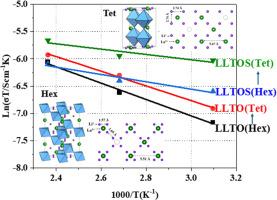通过四方相形成增强氧化硫化锂镧钛的离子电导率
IF 5.7
3区 材料科学
Q2 MATERIALS SCIENCE, MULTIDISCIPLINARY
引用次数: 0
摘要
采用固态法合成了锂镧钛氧化物(LxLyTO)和氧硫化物(LxLyTOS)作为全固态电池的固体电解质。粉末产品呈现钙钛矿型结构,采用NH4F助熔剂形成六方和四方晶系。通过x射线衍射分析,确定了合成产物的物相鉴别和受合成条件影响的单胞参数。在50 ~ 150℃的温度范围内,利用电化学阻抗谱(EIS)测定了压实LLTO-S球团的离子电导率,产率在2.3 × 10-7 ~ 2.9 × 10-5 S/cm之间。在LxLyTOS球团中观察到的电导率增强归因于四方相的存在和高退火温度的应用。对LxLyTOS样品在1000°C和1200°C退火后的形貌进行了表征,特别关注晶粒的生长。为了解耦体积和界面的影响,利用等效电路模型通过EIS提取了体积离子电导率。本文章由计算机程序翻译,如有差异,请以英文原文为准。

Enhancing ionic conductivity in lithium lanthanum titanium oxysulfides through tetragonal phase formation
The lithium lanthanum titanium oxides (LxLyTO) and oxysulfides (LxLyTOS) were synthesized via a solid-state method for use as solid electrolytes in all-solid-state batteries. The powdered products exhibited perovskite-type structures, adopting hexagonal and tetragonal crystal systems using NH4F flux. Phase identification and unit cell parameters of the synthesized products, as influenced by the synthetic condition, were determined using X-ray diffraction analysis. The ionic conductivities of pressed LLTO-S pellets were measured using electrochemical impedance spectroscopy (EIS) over at temperature range of 50–150 °C, yielding values between 2.3 × 10–7 and 2.9 × 10–5 S/cm. The enhanced conductivity observed in LxLyTOS pellets was attributed to the presence of the tetragonal phase and the application of high annealing temperatures. The morphologies of LxLyTOS samples annealed at 1000 and 1200 °C were characterized, with particular focus on particle grain growth. To decouple bulk and interfacial contributions, bulk ionic conductivity was extracted via EIS using an equivalent circuit model.
求助全文
通过发布文献求助,成功后即可免费获取论文全文。
去求助
来源期刊

Materials Research Bulletin
工程技术-材料科学:综合
CiteScore
9.80
自引率
5.60%
发文量
372
审稿时长
42 days
期刊介绍:
Materials Research Bulletin is an international journal reporting high-impact research on processing-structure-property relationships in functional materials and nanomaterials with interesting electronic, magnetic, optical, thermal, mechanical or catalytic properties. Papers purely on thermodynamics or theoretical calculations (e.g., density functional theory) do not fall within the scope of the journal unless they also demonstrate a clear link to physical properties. Topics covered include functional materials (e.g., dielectrics, pyroelectrics, piezoelectrics, ferroelectrics, relaxors, thermoelectrics, etc.); electrochemistry and solid-state ionics (e.g., photovoltaics, batteries, sensors, and fuel cells); nanomaterials, graphene, and nanocomposites; luminescence and photocatalysis; crystal-structure and defect-structure analysis; novel electronics; non-crystalline solids; flexible electronics; protein-material interactions; and polymeric ion-exchange membranes.
 求助内容:
求助内容: 应助结果提醒方式:
应助结果提醒方式:


